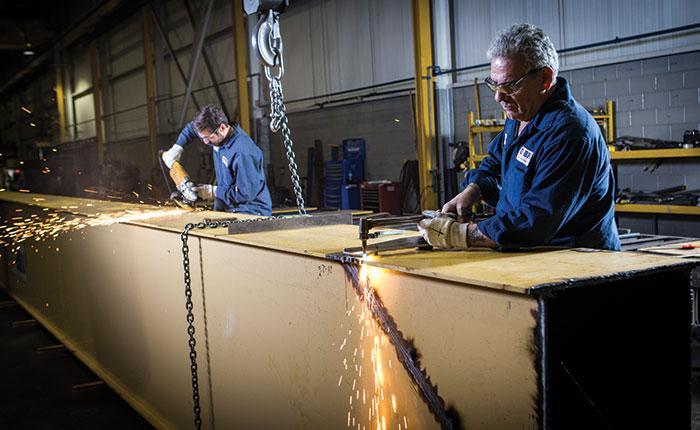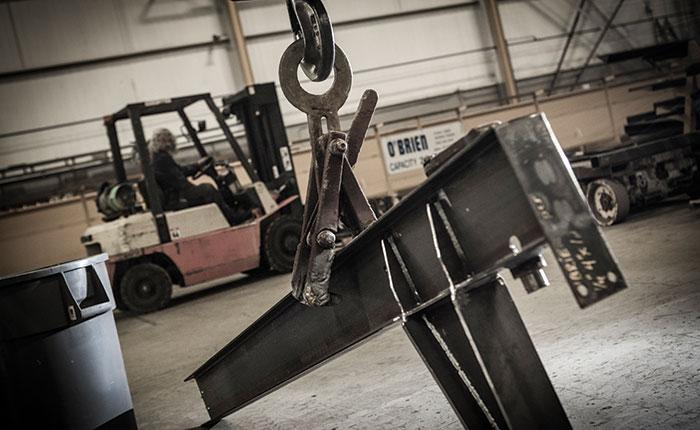- FMA
- The Fabricator
- FABTECH
- Canadian Metalworking
Carrying the Weight
O’Brien Installations: Building and installing custom cranes and doors for more than 50 years
- By Joe Thompson
- April 9, 2014
- Article
- Made In Canada

Glen O’Brien, president of O’Brien Installations (left), and Wayne Davis, vice president, stand in front of one of the company’s custom jigs. O’Brien’s cranes are shipped across Canada and into the U.S. Photos by Jon Evans Photography.
It all started with a plan … a plan and a used station wagon.
In 1963 Hugh O’Brien started a family and a business in Hamilton, Ont. Today the two are inseparable and synonymous with the crane business in Canada. O’Brien Installations, now located in Burlington, Ont., has come far from its humble beginnings and is now a recognizable brand of material handling systems.
The company is a manufacturer of overhead and jib cranes and a supplier of commercial doors and loading dock equipment. In addition to its 47,000-sq.-ft. sales, service, and manufacturing facility in Burlington, the company also has a sales and service office in Quebec City and another sales, service, and manufacturing facility in Memramcook, N.B.
The company started, however, with a $1,000 loan and a used car.
“My father worked at a company in the door installation business, but knew he could go further if he had his own company,” explained Glen O’Brien, the current president. “He started installing one-piece residential garage doors as a side business, and then started installing Richards-Wilcox commercial doors. That’s what started the ball rolling. I have seen pictures of that station wagon with a stack of garage doors on the roof.”
The founding O’Brien also had another resource that would come in handy in his installation business: family. Out of 17 siblings he had nine brothers who were looking for work.
With youngest brother George, who was 17 at the time, Hugh began installing doors, cranes, and even gymnasium partitions.
In 1967 the company moved to Stoney Creek, Ont.
It was, however, a business that revolved around the installation of products that other companies built. Then in 1974, a major corporate milestone was reached, and the evolution of the company started.
“The big turning point in my dad’s business life was when he signed a deal with Demag to sell and install their product,” said O’Brien. “This meant that the company had to manufacture these cranes as well, and that was a huge step forward.”

Very large structural components require many hours of prep work and welding before assembly and paint.
O’Brien Today
In 2011 the company moved from Stoney Creek to its current location. Manufacturing, installation, and service of material handling systems, as well as door and docking assemblies, are what the company is known for today.
Specifying a material handling system often starts with a needs assessment.
“I think that’s one of the areas that we really specialize in,” said O’Brien. “A potential customer will call and ask us to solve a problem that they are having. We then help them determine what type of handling system best suits their needs.”
The other type of end user already has cranes installed in its facility and simply needs to add another to a certain area of the building.
No matter which type the customer is – experienced or novice -- most are very knowledgeable.
“There is a lot of information out there now that wasn’t available 25 years ago, and customers are now appearing with a good idea of what they need already,” said Vice President Wayne Davis.
Ultimately, each case is different, but the need to move material efficiently and safely remains constant.
“The solution might be an overhead crane, jib crane, light-rail system, or simply a fork truck,” said Davis. “It’s our job to design and implement the best system for each facility that we visit.”
The company deals directly with its customer base in southern Ontario, Quebec, and New Brunswick, and it has a dealer network throughout the rest of the country and the U.S.

Workers at the company’s Burlington, Ont., facility refurbish a crane for an existing customer who recently moved to a different location and required a shorter crane.
“From a logistics standpoint, it just doesn’t make sense for us to send one of our technicians to British Columbia, for example,” said O’Brien. “That’s why we have a network of dealers that have qualified and certified technicians.”
The company’s technicians keep the cranes operational and safe. It fields a staff of 20 service technicians, including five in Quebec, and many of these employees have more than 20 years of experience.
Future Needs
Having such a veteran staff means that in the near future the company will need younger people to fill these roles. It’s a process that is starting now thanks to an apprenticeship program with Hamilton’s Mohawk College.
O’Brien always has two or three apprentices going through the program as part of its field staff. Then, following the apprenticeship, they can go out in the field on their own, and a new crop of apprentices are brought in.
“The apprentices usually start with an electrical or millwright background, and then we train them on crane work,” said O’Brien.
It takes a lot to be a certified crane technician. Each worker must have 10,000 hours of crane-related experience to meet the Ministry’s requirements to inspect and service this equipment.
“They also need to be more computer-savvy now, since many cranes have downloadable data that needs to be read during troubleshooting,” explained Davis. “Event logs can track if the crane was overloaded and send messages when maintenance is due.”
The field staff isn’t the only department with experience.
“The people that we have here now are the core of the business,” said O’Brien. “There are a lot of people that have been with the company for 25 years and longer, and I can see us having some issues in the future when these longtime employees retire.”

Crane components are ready for installation. Each crane requires much welding, making this process an important part of the construction phase.
This is the case with the company’s fitters/welders.
“If you talk to anyone in the fabrication industry, you will hear that welders are becoming harder and harder to find. I see this as a potential problem area for us, because everything we do – whether it’s a jib crane, rail system, or a large overhead crane -- gets welded on our shop floor,” said Davis.
The company also needs welders with a number of different tickets, including flux-cored arc welding (FCAW) in all positions. Submerged arc welding (SAW) also is performed in the shop.
Kit Versus Custom
The work on the shop floor includes production of cranes that are more stock in nature and those that are completely custom.
“If a customer needs a fairly standard 5-ton crane with a 40-ft. span, we can take the necessary components off the shelf and assemble it in-house relatively quickly. We order the bridge beam already cut to the correct length and assemble it as a kit,” said Davis.
This type of work requires only a small amount of engineering. However, as the cranes get more complicated, more engineering work is performed, and more custom fabrication work is necessary.
“Every crane that goes out of here, even the ones that are common, is different. It makes automation nearly impossible, which again places so much importance on our welders,” said O’Brien.
The company’s welders use special fixturing and jigs to hold and manipulate the workpiece, turning it as necessary.
Before each crane is shipped it is painted the company’s distinctive yellow in one of the longest paint booths in Ontario.

Interior electrical components (shown here) are combined with mechanical and structural components on the shop floor to create each custom crane.
“It’s a never-ending battle to stay competitive in the market and still give the customer the same quality they are used to from us,” said Davis.
With the manufacturing ability in Canada that its competitors don’t have, O’Brien has the flexibility to enable fast turnarounds for rush jobs.
“If you do all your manufacturing through subcontractors, you lose the ability to place a rush on certain orders,” said Davis. “Here we can walk out to the shop floor and move jobs around to facilitate a new order.”
“It’s the same with engineering,” explained O’Brien. “Our in-house engineering department allows us to maintain a large work load of custom work. A lot of companies want to get away from this custom work, but because we have in-house engineering and manufacturing, we can excel at it.”
New Business
One recent new production item in the shop in the last few years is the company’s light-rail system.
“It has the potential to be big for us, because no one else in Canada is really doing this type of work,” said Davis. “In the next five years I think we are going to see tremendous growth in this area.”
Last year the company celebrated its 50th anniversary, with staff, customers, and local dignitaries on hand to take part in the celebration.
Now more than 50 years later, Hugh O’Brien’s plan still is in place, but the station wagon has been replaced by a fleet of service vehicles.
“Dad has now left me with the challenge of taking the company into the future,” said O’Brien.
subscribe now


Keep up to date with the latest news, events, and technology for all things metal from our pair of monthly magazines written specifically for Canadian manufacturers!
Start Your Free Subscription- Trending Articles
- Industry Events
MME Winnipeg
- April 30, 2024
- Winnipeg, ON Canada
CTMA Economic Uncertainty: Helping You Navigate Windsor Seminar
- April 30, 2024
- Windsor, ON Canada
CTMA Economic Uncertainty: Helping You Navigate Kitchener Seminar
- May 2, 2024
- Kitchener, ON Canada
Automate 2024
- May 6 - 9, 2024
- Chicago, IL
ANCA Open House
- May 7 - 8, 2024
- Wixom, MI















